When I stepped off the plane on the night of May 11th and breathed in the wet, heavy air, I instantly knew I was truly in another world. After 17 hours in the sky, 3 time zones and as many layovers, I had left the snow covered ground in Denver behind for a chance to explore the tropical island of American Samoa. Though my eyelids drooped, and my shoulders felt heavy, my mind reeled from the sensory overload provided by the humid stormy night.
American Samoa truly is another world. Like many people from the States the name “American Samoa” held an air of mystery, partly because it seems that almost no one from back home knows where this place is. Located about 14º south of the Equator, slightly west and south of Hawaii, American Samoa is hardly more than a series of dots in the vast emptiness of the South Pacific.
When I landed in American Samoa I had no idea what expect, or even who was going to meet me at the airport. As it happens, a good friend of mine from Santa Cruz has been working for the Park Service in American Samoa for almost a year. I was very grateful to see the long lost face of Ian Moffitt at the airport. Although it was exhilarating to finally be here, the adrenaline of almost missing my connection in Honolulu to the once-weekly flight to American Samoa was slowly fading, I was truly thankful when we pulled up to the interns’ house late that night.

A few of the interns entering the water at Amalou, the first place i got to dive
The National Park of American Samoa (NPSA), covers over 10,000 acres and approximately 4000 acres of it is underwater. The dive team certainly has it work cut out for it. The NPSA dive team has undertaken many different scientific studies and projects related to the conservation of the National Park. Most recently they are spearheading an island-wide effort to help control the outbreak of the Crown-of-Thorns Sea Star, a voracious echinoderm that preys primarily on the living tissue of coral reefs.
We hit the ground running at 7:30 am on my first day and I was glad to hear we were headed into the field. After a week in Denver, and over a day of air travel, I finally felt in my element again. Loading tanks, prepping gear and heading out into the field I felt an instant connection with the 4 other interns. I couldn’t contain the smile on my face as we speed out of the Fagasa bay in the Park Service’s open deck Boston Whaler on the way to the field site. The crystal clear waters and dense island flora clinging to the rocky coastline immediately blew me away; the island’s steep cliffs drop vertically into the sea and make for a very dramatic boat ride.

an image of the coral reef (taken at about 45′)
Much to my chagrin I had to wait 24 hours after flying before I could don my scuba gear with Park Service, so I contented myself to snorkeling and free diving around the team as they completed their inventory and monitoring surveys. Never before have I been able to swim in water so warm and clear
I couldn’t wait to dive with NPSA for the next two weeks, but unfortunately the weather had other plans. After that Tuesday the island was battered by harsh winds and incessant rain, making field operations all but impossible. The NPSA dive team doesn’t get much downtime, so when the weather is uncooperative they have to make the most of it. I was tasked to assist with the maintenance issues that typically accompany field operations. Normal wear and tear on boats, scuba gear and field equipment is further compounded by American Samoa’s constant humidity and moisture. Needless to say we had our work cut out for us.

Another reef shot (probably amalou in about 35ft of water)
However, as the week rounded out the weekend showed promise for nicer weather. With hope rising we set out on a relatively calm Saturday morning to try our hand at diving on the North side of the island. Because American Samoa is ringed by fringing reefs, scuba diving is best planned around high tide. As we waited for the tide to rise we snorkeled in some of the most amazing tide pools I’ve seen. Vibrant corals and hardy algae cling to the volcanic walls of Vatai tide pools, nestled above the crashing surf.
After swimming in bathtub-like waters for an hour or two we hiked back up to the car and drove down the road to Amalou, where I would finally get to dive on the reefs that had tantalized me all week. Though the rest of the dive team complained about the poor visibility (only about 60ft!) and the relatively “cold” water, I could barely contain my excitement. Getting to dive in 82º water, in just board shorts and a rash guard, for over an hour is something I won’t soon forget. Though the reefs have been impacted by overfishing, I was blown away by the size and color of the coral found along the steep reef slopes. Massive Porites dwarf even the largest natural structures I’ve ever seen in a kelp forest. The various forms and colors of Acropora are like something out of a Dr. Seuss story. The rest of the dive team casually cruised the reef; this was their day off after all so they too could enjoy the wonders the reef had to offer.
-
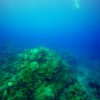
-
A large reef structure, separate from the reef slope. taken in about 35ft of water (looking down) that structure must have been over 20ft tall!
-
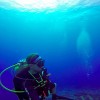
-
Just a picture of me diving at fangamalo
-
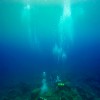
-
Swimming in from our last dive at Fangmalo, the NPSA dive team (minus Ian) swims in after a fun dive
-
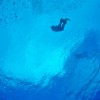
-
Ian Moffitt, “lead” intern, freediving above us at Fangamalo
During our surface interval, as we planned for a second dive, I heard talk that Ian was planning on skipping the second dive in search of surf-able waves, an activity also best planned around a high tide. Back home in California one rarely has to choose between surfing and diving, the ability to pursue either activity typically precludes the other. Needless to say, I jumped at the chance for a “perfect day”. In a refreshing change of pace we found the closest surf break to be entirely sheltered from the wind. We traded waves by ourselves for an hour as the sun serenely set behind the mountains of American Samoa. And I didn’t even have to change out of my board shorts! I could get used to leaving my neoprene at home.

Typical American Samoan transportation with Kersten Shnurle, another NSPA intern
While Sunday was no different than any of the other days that week, we decided to brave the weather and climb the steep trail to Mt. Alava, the second highest point on the island. Because it was one of the intern’s birthdays, a large group of eager hikers set out to brave the 3 hour long hike to the top of the mountain. Like something out of Jurassic Park, primeval fog obscured the all but the trail in front of us. The trail winds across the spine of the island’s mountains, the shifting clouds provided us with brief glimpses of the coast below.
The rest of the workweek proceeded much like the last; rain and wind lashed the coast and kept us high and dry in the office. Again, I jumped in with the “maintenance crew” doing repairs and preventative care on the field support equipment. I quickly realized how much I have taken for granted how easily accessible parts and tools are back on the mainland. On an island that is infrequently visited by cargo ships even the simplest of repairs can be thrown off if a single nut or bolt can’t be purchased. Needless to say I was thoroughly impressed with the resourcefulness and positive attitude the dive team constantly maintains.
As luck would have it Saturday looked like the weather might break, at least for a couple of hours. We loaded up the gear and drove the length of the West Road. Winding first south, then west and eventually north we drove past villages, rainsqualls and idyllic beaches pounded by heavy surf. No one had their hopes up as we rounded through the final mountain pass and dropped into the little village at the end of the road. Like something out of a fairytale the little bay of Fagamalo opened up before us; we were greeted by blue skies and calm water. Ecstatic, we geared up and jumped in the water, after obtaining permission from the village chief of course.

Schooling reef fish (ID still unknown) taken at Fangamalo in about 50ft sea water
After surface swimming across the fore-reef, we dropped down into crystal clear water over an immaculate coral reef. Because Fagamalo is bordered by a marine protected area, or MPA, to the north, the reef was teaming with wild arrays of fish and invertebrates. While swimming past the massive 3-dimensial coral structures, examining reef fish and their bright colors, I finally met the antagonist of the NPSA marine program, the Crown-of-Thorns Sea Star. A voracious coral predator, these fast moving sea stars are as dangerous as they are beautiful. Ringed by poisonous spines they are hard to remove, and given certain conditions can turn a vibrant coral reef into a bleached graveyard. While scientists are still debating about the cause of recent outbreaks, there is evidence that they are becomingly increasingly abundant on coral reefs across the Indo-Pacific. Although the dive team’s main assignment is their removal, they are naturally found on coral reefs and it was certainly exhilarating to see a few on our dive.

A school of sweetlips swims over the reef at Fangamalo. Sweetlips are one of the target species for the fish tracking project

The Crown-of-Thorn Seastar, the NPSA dive team’s current antagonist. Though they’ve been able to control outbreaks inside the national park, CoTs remain an issue on less managed reefs
As we drove home through the rain I was able to reflect on my previous underwater foray. Though these last two weeks in American Samoa didn’t turn out quite as expected, but I am anything but upset. Saturday’s dive alone made up for a frustrated week of uncooperative weather; it takes months of preparations to properly execute field operations and I was more than happy to help out in any way I could.
I won’t soon forget American Samoa, its gregarious people, and the oppressive tropical weather that makes this place so beautiful. And I certainly won’t forget the openhearted generosity of the NPSA staff. I would like to thank Dr. Tim Clark, NPSA’s marine ecologist, and especially the dive-team, aka the “Tim-terns” that housed me and showed me ropes over the last two weeks; Kersten Shnurle, Paolo Marra-Biggs, Karen Bryan and of course Ian Moffitt. Now I’ve got to pack my bags and head north, to the island of Oahu to explore the WWII Valor in the Pacific National Memorial.
Fa’afetai!











































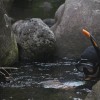
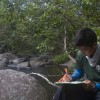
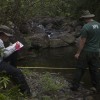






 A gun turret on the USS Utah
A gun turret on the USS Utah















































